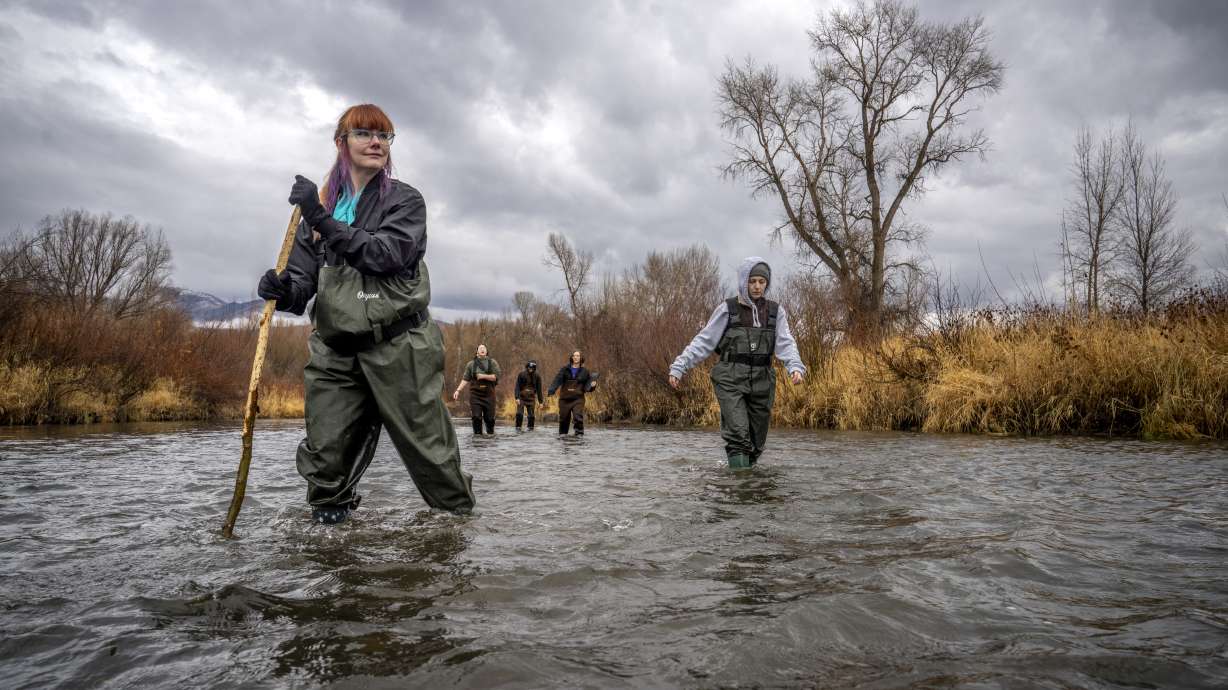Estimated read time: 4-5 minutes
This archived news story is available only for your personal, non-commercial use. Information in the story may be outdated or superseded by additional information. Reading or replaying the story in its archived form does not constitute a republication of the story.
OGDEN — College students at Weber State University are searching the Weber River for otters to track the elusive species' migration and population.
Weber State zoology professor Michele Skopec and a team of 10 students are surveying local waterways to learn about North American river otters and migration paths. The researchers spend every other week setting up cameras and lures along the Weber River in the hopes of capturing footage of the animals.
Because river otters travel up to 60 miles a day, the team has been changing camera locations every two weeks to increase their chances of finding the otters. Zoology major and lead student researcher Rossetta Chen said the otters could be near ponds or lakes as they prefer deep, still water.

"(Otters) are mostly out at night and they have such a wide range that they go all over the place," she said. Otters can also be difficult to track as they use other animals, such as beavers, whose dens they can steal, she said.
The researchers have gone out five times to set up the cameras in different spots and have collected hundreds of hours of footage to search through. They hope to be able to track where the otters in Utah are living, to determine how the population is faring.
Chen didn't realize Utah even had otters. River otters are native to Utah but, in the late 1800s, the species almost went extinct due to high amounts of trapping and hunting for the fur trade, she said.
Conservation laws were implemented to protect the species after it was classified as rare in the 1890s, a press release from Weber State states. Otters have been released into the Provo River in years past with the hopes of boosting the population and the university project seeks to figure out how the animals are doing and if more releases or conservation is necessary.
"It's really just about trying to find them right now," she said, adding that the animals can be quite elusive.
Sightings and video footage of otters give researchers a way to collect information on the location and distribution of the species. This data can give insight on how to create management plans for the creatures' population and conservation.
"There's a lot to learn about river otters' culture and behavior," Chen said. "We can't have conservation laws without knowing more about the population."
So far, however, Chen's team hasn't spotted any otters.

"Even if we don't, that's important because then that means maybe the river is not doing well or we need a boost in population. It's still useful even if we find other animals," Chen said.
The researchers will help to asses the health of ecosystems, as otters are an indicator species — a species whose presence signals a thriving ecosystem, Chen said. Otters require a lot of food and they don't do well if the river is polluted, she added.
"Because they're so dependent on a good environment, if they are missing or they are not doing well, that's an early sign the river isn't doing well in general," she said. "There's a lot we don't know about river otters, especially Utah river otters."
Chen explained all otters have their own cultures, different ways of learning and regional behaviors.
"We don't know what Utah river otter culture is or their specific behaviors, so there still is a lot we would benefit from knowing about them," she said.
Chen hopes the project will continue because there are plenty more rivers to research. She wants other colleges to join in the project so a broader area can be covered. The team also gets a lot of information from anglers who report otter signs and sightings.
Britnee Cheney, an expert at the Loveland Living Planet Aquarium in Draper, started an otter conservation project in 2022. She started surveying the Provo River and her team spotted six otters last year. The aquarium team now surveys the Strawberry River, but it still works closely with Chen's team and they both share findings with each other.
"Our goal is to get more information about where otters are located, how they're doing and how many there are," Cheney said. "That way, we can figure out what they may need from us in the future."
Research findings are also shared with the Utah Division of Wildlife Resources, so the department can better help manage the species, improve struggling ecosystems and maintain healthy ecosystems.
Chen said research on animals helps people better understand the world in which they live.
"We don't often get to see most of the animals out in the wild and there's a lot we don't know. So it's like that genuine human curiosity and just understanding what's out there and why animals do the things they do. Because back in the day we used to not believe animals were intelligent or had personalities, but it's been way more widely accepted that these are things to research about," she said.









